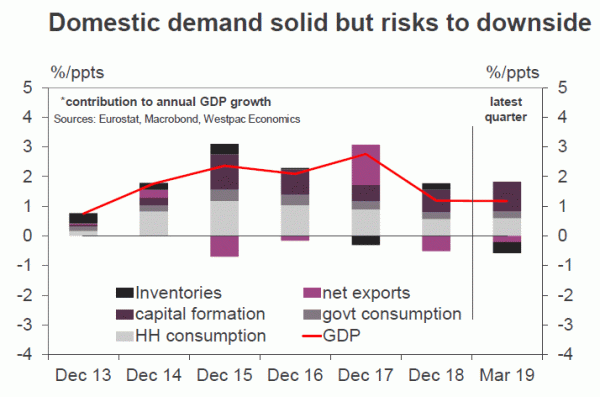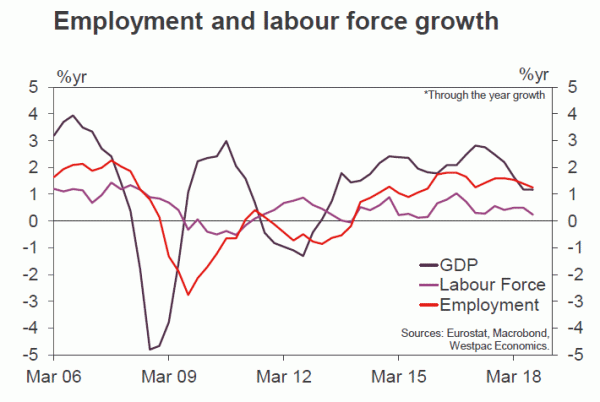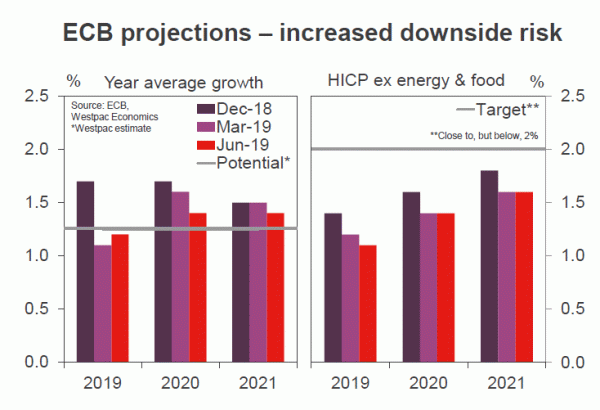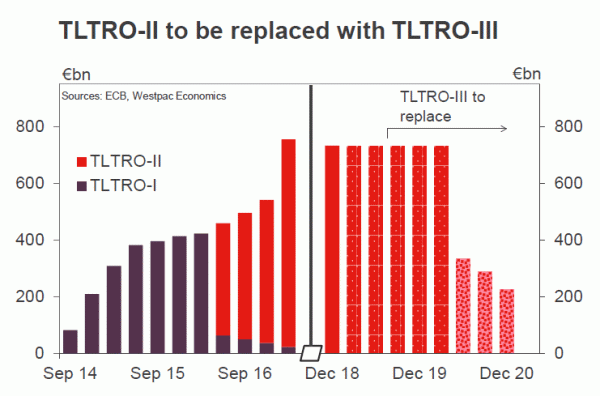The June ECB meeting marks a continued shift among central bankers to express a willingness to act if conditions were to weaken. Ultimately, this is an acknowledgement that high economic uncertainty is going to linger for some time and downside risk has increased. The main message from the meeting is that the ECB is “ready to act”.
Regarding policy decisions, they are somewhat more ambiguous. Forward guidance was extended to rates being on hold at least through the first half of 2020, but the decision on TLTRO-III (new loans to banks) was to provide slightly less favourable pricing than its maturing predecessor TLTRO-II.
Starting with the ECB’s economic outlook, the June meeting provided relatively unchanged projections from March. The ECB sees moderate, around-trend growth through the forecast horizon. The out years were lowered slightly but 2019 revised up slightly with the profile now 1.2% in 2019 and 1.4% in 2020 and 2021.
The unemployment rate track has been lowered but with only gradual improvement seen over the forecast horizon. The unemployment rate has fallen to 7.6% as at April, down from 8.4% a year earlier. The ECB sees the trend flattening, with a forecast 7.3% in 2021 – although note the pre-GFC low was 7.2%.
Inflation is still seen as modest, only gradually reaching 1.6% in 2021. President Draghi noted in the press conference that they are taking the decline in market based inflation expectations seriously, and notes that their inflation models show a mass of distribution between 0-1.5% – below the ECB target of close to, but below, 2%.
So all in all, the central view is relatively benign and Draghi notes that the data about the economy is not bad. But while the baseline is stable, the ECB’s concern about downside risks is elevated.
Draghi’s press conference emphasises that the ECB are aware of the “prolongation” of “increased” uncertainties. Key here is the threat of rising protectionism and the effect this has already had on lowering trade growth.
With that in mind, the ECB are ready to act in the case that adverse contingencies materialise. Indeed, members raised the possibility of further rate cuts, restarting the asset purchase program or extending forward guidance on rates even further.
So what are these adverse contingencies? The dominant worry relates to the persistent weakness in the manufacturing sector which is more exposed to external demand. While he notes that domestic demand remains robust (the Q1 national accounts show it currently tracking at 1.9% annual growth) he questions how long these areas of the economy can remain “insulated” from the difficulties in the manufacturing sector.
Accordingly, Draghi was questioned in the press conference on the effect on the banking sector of an even lower policy rate. Here, Draghi reiterated that in “aggregate”, the ECB do not see damaging side effects from the current level of negative interest rates. Of course, if these were to appear, they would consider mitigating measures. That is a tacit acknowledgment of the possibility of tiered rates but no indication that this policy will be implemented in the near-term.
On that note as well, the pricing decision on TLTRO-III was within the range of market expectations. As with its predecessor, TLTROII, banks will receive loans at a base rate linked to the refi rate (currently 0%) with a conditional rate linked to the deposit rate (currently -0.4%) if banks exceed lending benchmarks.
The key difference is that the new loans will come at a 10bps premium to the linked policy rates, and the linked rate that applies will be the average over the life of the respective TLTRO operation. Previously at the March meeting, we learned that TLTRO-III operations will be made at quarterly intervals from September 2019 to March 2021, with loan maturities of two years. These will replace TLTRO-II, where the first operation (roughly 50% of the stock) matures in June 2020 – although note under bank’s required stable funding regulation, the effect of maturities will be felt from June 2019. Draghi’s rationale behind the TLTRO-III decision was that the loans are intended to be a backstop, and while there is a slight “disincentive” to before, the terms are still very generous.















